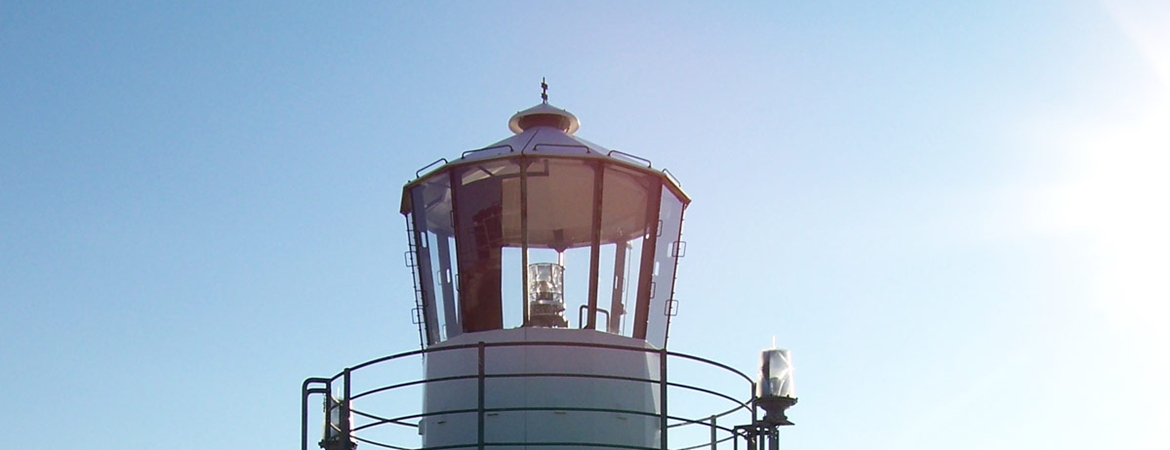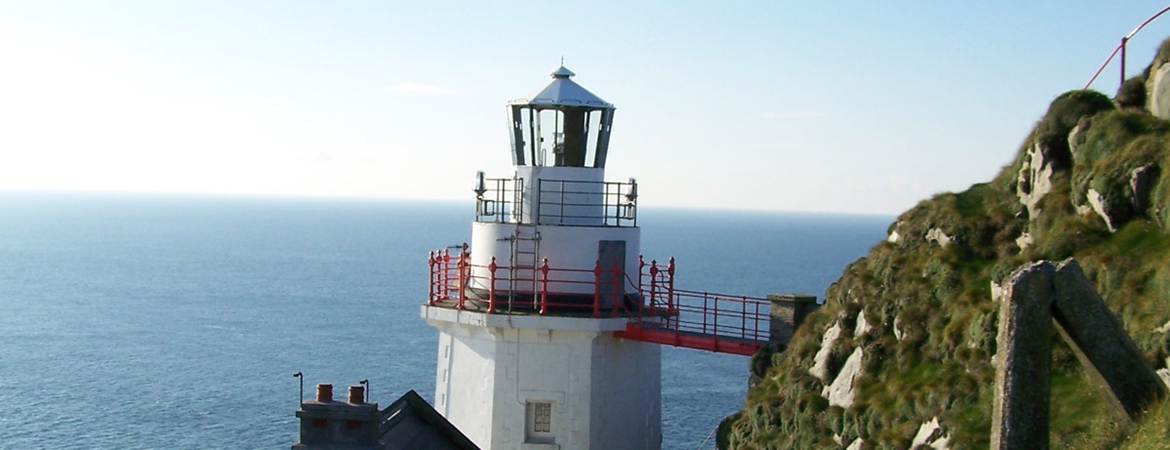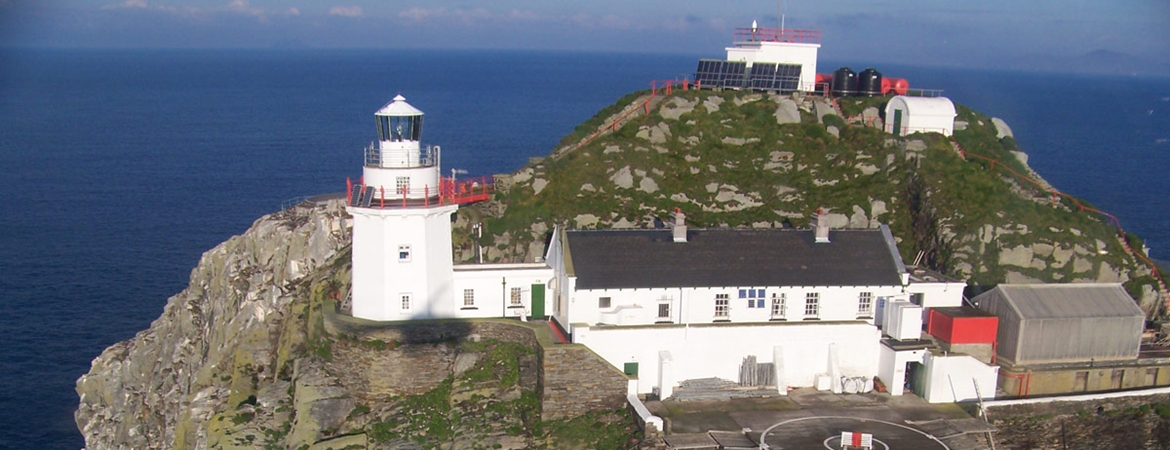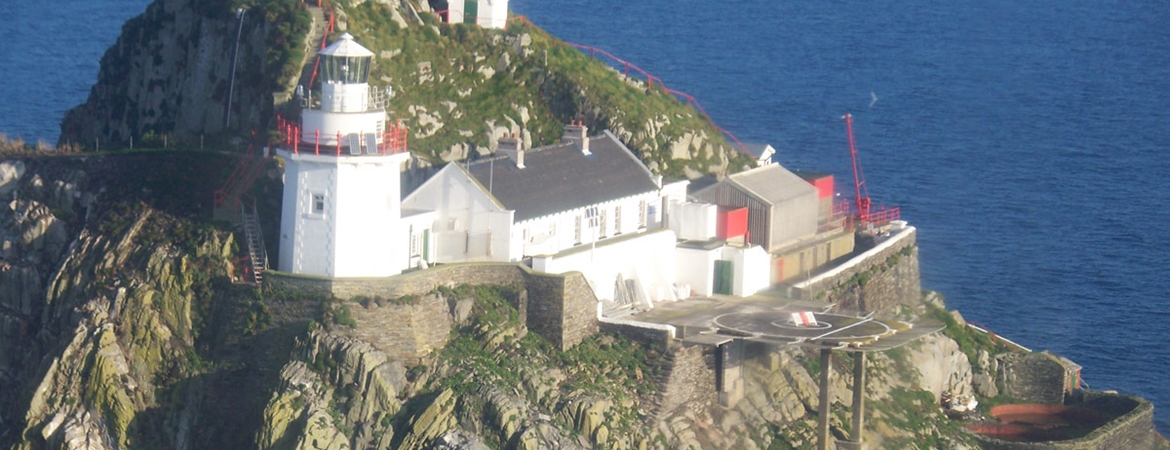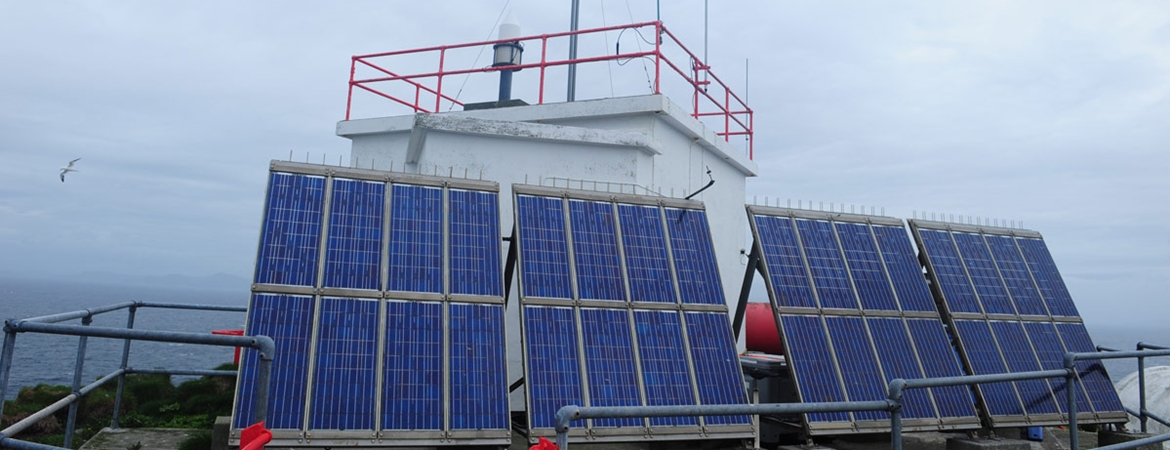In March 1846 Captain J. Wolf of the Royal Navy wrote to the Hydographer requesting that a lighthouse be established on Bull Rock, Galley Head to the west of Kinsale Old Head, and on the Foze Rocks off the Blasket Islands. In 1849 the Cork Harbour Commissioners reminded the Corporation for Improving the Port of Dublin of this letter and enquired if the Board contemplated adopting the suggestions. The Board's Inspector George Halpin reported on the situation and in the outcome Galley Head was approved but the Bull and Foze Rocks were postponed. During protracted discussions between Trinity House, the Board of Trade and the Corporation which went on until 1858, Bull Rock fell out of favour with Trinity House and the Board of Trade despite the Corporations' preference for the Bull, and Calf Rock was chosen as the site for the lighthouse. George Halpin submitted plans and an estimate for a cast iron tower, with floors of Valentia slate similar to the tower on Fastnet Rock, which was at that time four years old.
Henry Grissell of Regent's Canal Iron Works, London, secured the contract for building the tower and rock dwellings in 1861.
Meanwhile investigations were going ahead as to who owned the rock; unsuccessfully at first, then followed by a Sheriff's inquiry which resulted in January 1859 with the Corporation receiving a letter from the Commissioners of Woods and Forests stating that Her Majesty Queen Victoria owned Calf Rock. The Corporation bought the rock for £26.5s.0d.
Grissell completed the tower in August 1864. The lantern, optic and revolving machinery were added the following year making the tower 121 feet high. The light was established on 30 June 1866, 136 feet above high water.
Shore dwellings for the Keepers and their families were built on the mainland at the south end of Dursey Sound.
A severe storm early in 1869 washed away a section of the lantern balcony rail and a hut containing stores. The Keeper ashore thought he saw distress flags on the rock so with six boatmen braved the stormy seas only to find the Keepers on the rock were safe and sound. When the boat turned to return to the main land it was caught by the sea and capsized, all hands were lost.
During 1870 the base of the tower was strengthened by increasing the diameter from 20 to 31 feet. A cast iron skirt was added and the space between the skirt and the tower filled with rubble.
On 27 November 1881 the lighthouse was destroyed by a violent storm, the tower complete with lantern snapped off above the strengthened base and fell into the sea. Fortunately neither the Keepers nor the three other men were in the tower and all six were taken off the rock two weeks later by the boat attendant helped by HMS Seahorse.
Immediate steps were taken to establish a temporary light at the west end of Dursey Island. This consisted of a spare lightvessel lantern from the Lighthouse Stores at Dun Laoghaire superimposed on a three-roomed wooden structure, complete with a twenty-five foot six inch high by fifteen-inch diameter mast down through the centre of the lantern and middle room. To complete the structure a wooden balcony ran around the lantern, the mast was stayed to the ground with four lengths of chain and an eight-foot high boundary wall was built close to the wooden structure. The light was put into operation on 2 February, 1882. The boundary wall around the temporary station can still be seen.
With Calf Rock damaged beyond repair thoughts turned back twenty years to Bull Rock being the most suitable of the three rocks the Calf, the Cow and the Bull for the lighthouse, so in February 1882 the Inspecting Committee of the Commissioners of Irish Lights recommended Bull Rock to Trinity House. The following month sanction was granted by the Elder Brethren and the Board of Trade requested estimates. No difficulty was experienced in securing the rock, as it too was owned by Queen Victoria and the Commissioners of Woods and Forests. The rock was acquired from her Majesty for £21.
Bull Rock is notable for the natural tunnel running right through it. It is situated off the entrance to Kenmare River, five-and-a-half miles from the mainland and two-and-a-half miles from the nearest point of Dursey Island. It measures roughly 750ft by 540ft; the sides are steep and rugged and the summit is 305ft above sea level.
Work commenced on 21 April by landing a party of miners with a coil of rope, eye bolts, a light spar, and some boring tools. The men climbed the rock with difficulty, dragging the spar with them, until they reached a height of 110ft. Here they selected a suitable site for fixing derricks, and by means of the spar, two heavier spars were lifted and fixed as derricks. Then two jack-roll winches were landed and with these a workmen's hut, water, provisions, and coal were landed. Before building work could commence it was necessary to excavate level sites for the buildings, and to extend the illuminated arc of the light to the greatest extent possible. A total of 15,957 cubic yards of hard rock was excavated. Over 300 steps had to be cut out of the side of the rock to gain access from the boat landing to the site for the tower.
The station consisted of an octagonal lighthouse tower, dwellings for the Keepers, an oil-gas works to supply gas for the burners in the optic and an explosive fog-signal, together with steps, boat landings, dericks and hoists. The work was of an enormous scale. The bi-form hyper-radial optic was the biggest in Ireland.
The station was completed in 1888 and on 1 January 1889 Bull Rock's light and fog signal were established. The temporary light on Dursey Island was discontinued.
The first major alteration to Bull was the replacement of the explosive fog-signal by a siren with three trumpets operated by air from compressors in the engine room. The change over took place on 1 April 1902.
The next alteration was on 28 June 1910 when the light was converted from oil-gas to vapourised paraffin causing the candlepower to be greatly increased still using the same optic.
The light was converted to electric power on the 21 August 1974, increasing the candle-power still further to 4,500,000.
From 25 April 1978 the light was exhibited in poor daylight visibility.
The fog signal was discontinued on 17 May 1989.
On 31st March 1991 the lighthouse was converted to automatic operation and the Keepers were withdrawn from the station. As part of the automation process the original lantern and optic, which was too large to be automated, were replaced by a much smaller lantern and quartz halogen lamps giving a high intensity light with low power consumption. The station was placed in the care of an Attendant, the aids to navigation being monitored via a telemetry link with Irish Lights at Dun Laoghaire.
A Racon (radar beacon) giving identification code Morse N was established from 15 May 1998 (coinciding with of the racon at Mizen Head) and exhibition of the light during reduced daylight visibility was discontinued.
On the 6 October 2000 the station was converted to solar power and the original lantern was replaced by a Pelangi PRL400 electric lantern with a 35W CDM discharge lamp powered by 32 50W solar panels and a 24V 5,500 Ah battery.
Henry Grissell of Regent's Canal Iron Works, London, secured the contract for building the tower and rock dwellings in 1861.
Meanwhile investigations were going ahead as to who owned the rock; unsuccessfully at first, then followed by a Sheriff's inquiry which resulted in January 1859 with the Corporation receiving a letter from the Commissioners of Woods and Forests stating that Her Majesty Queen Victoria owned Calf Rock. The Corporation bought the rock for £26.5s.0d.
Grissell completed the tower in August 1864. The lantern, optic and revolving machinery were added the following year making the tower 121 feet high. The light was established on 30 June 1866, 136 feet above high water.
Shore dwellings for the Keepers and their families were built on the mainland at the south end of Dursey Sound.
A severe storm early in 1869 washed away a section of the lantern balcony rail and a hut containing stores. The Keeper ashore thought he saw distress flags on the rock so with six boatmen braved the stormy seas only to find the Keepers on the rock were safe and sound. When the boat turned to return to the main land it was caught by the sea and capsized, all hands were lost.
During 1870 the base of the tower was strengthened by increasing the diameter from 20 to 31 feet. A cast iron skirt was added and the space between the skirt and the tower filled with rubble.
On 27 November 1881 the lighthouse was destroyed by a violent storm, the tower complete with lantern snapped off above the strengthened base and fell into the sea. Fortunately neither the Keepers nor the three other men were in the tower and all six were taken off the rock two weeks later by the boat attendant helped by HMS Seahorse.
Immediate steps were taken to establish a temporary light at the west end of Dursey Island. This consisted of a spare lightvessel lantern from the Lighthouse Stores at Dun Laoghaire superimposed on a three-roomed wooden structure, complete with a twenty-five foot six inch high by fifteen-inch diameter mast down through the centre of the lantern and middle room. To complete the structure a wooden balcony ran around the lantern, the mast was stayed to the ground with four lengths of chain and an eight-foot high boundary wall was built close to the wooden structure. The light was put into operation on 2 February, 1882. The boundary wall around the temporary station can still be seen.
With Calf Rock damaged beyond repair thoughts turned back twenty years to Bull Rock being the most suitable of the three rocks the Calf, the Cow and the Bull for the lighthouse, so in February 1882 the Inspecting Committee of the Commissioners of Irish Lights recommended Bull Rock to Trinity House. The following month sanction was granted by the Elder Brethren and the Board of Trade requested estimates. No difficulty was experienced in securing the rock, as it too was owned by Queen Victoria and the Commissioners of Woods and Forests. The rock was acquired from her Majesty for £21.
Bull Rock is notable for the natural tunnel running right through it. It is situated off the entrance to Kenmare River, five-and-a-half miles from the mainland and two-and-a-half miles from the nearest point of Dursey Island. It measures roughly 750ft by 540ft; the sides are steep and rugged and the summit is 305ft above sea level.
Work commenced on 21 April by landing a party of miners with a coil of rope, eye bolts, a light spar, and some boring tools. The men climbed the rock with difficulty, dragging the spar with them, until they reached a height of 110ft. Here they selected a suitable site for fixing derricks, and by means of the spar, two heavier spars were lifted and fixed as derricks. Then two jack-roll winches were landed and with these a workmen's hut, water, provisions, and coal were landed. Before building work could commence it was necessary to excavate level sites for the buildings, and to extend the illuminated arc of the light to the greatest extent possible. A total of 15,957 cubic yards of hard rock was excavated. Over 300 steps had to be cut out of the side of the rock to gain access from the boat landing to the site for the tower.
The station consisted of an octagonal lighthouse tower, dwellings for the Keepers, an oil-gas works to supply gas for the burners in the optic and an explosive fog-signal, together with steps, boat landings, dericks and hoists. The work was of an enormous scale. The bi-form hyper-radial optic was the biggest in Ireland.
The station was completed in 1888 and on 1 January 1889 Bull Rock's light and fog signal were established. The temporary light on Dursey Island was discontinued.
The first major alteration to Bull was the replacement of the explosive fog-signal by a siren with three trumpets operated by air from compressors in the engine room. The change over took place on 1 April 1902.
The next alteration was on 28 June 1910 when the light was converted from oil-gas to vapourised paraffin causing the candlepower to be greatly increased still using the same optic.
The light was converted to electric power on the 21 August 1974, increasing the candle-power still further to 4,500,000.
From 25 April 1978 the light was exhibited in poor daylight visibility.
The fog signal was discontinued on 17 May 1989.
On 31st March 1991 the lighthouse was converted to automatic operation and the Keepers were withdrawn from the station. As part of the automation process the original lantern and optic, which was too large to be automated, were replaced by a much smaller lantern and quartz halogen lamps giving a high intensity light with low power consumption. The station was placed in the care of an Attendant, the aids to navigation being monitored via a telemetry link with Irish Lights at Dun Laoghaire.
A Racon (radar beacon) giving identification code Morse N was established from 15 May 1998 (coinciding with of the racon at Mizen Head) and exhibition of the light during reduced daylight visibility was discontinued.
On the 6 October 2000 the station was converted to solar power and the original lantern was replaced by a Pelangi PRL400 electric lantern with a 35W CDM discharge lamp powered by 32 50W solar panels and a 24V 5,500 Ah battery.

